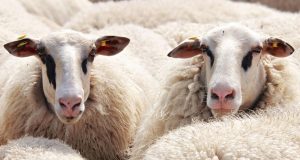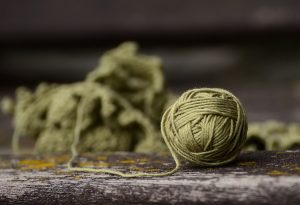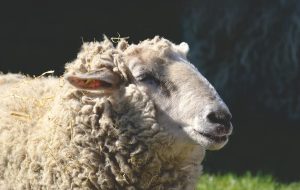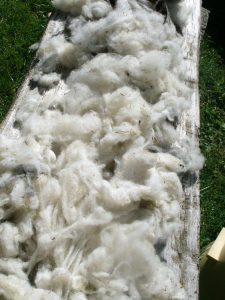
While cotton is the number one fibre, wool remains the main source of animal fibre used in fabric production. Anthropologists believe that humans were using wool already in the Neolithic age, developing the first manufacturing procedures.
In modern ages, wool became a successful trading business, long before it turned into the major industry that it is today. In those days people already had realized its usefulness. As a result, the wool trade prospered particularly during the 11th and 12th centuries. While Britain was the main wool producer, the Flemish had learned the art of manufacturing it. Thus, the raw material would go to the Flemish for production and then these sold the products back to the Britains.
But it wasn’t long before the British realized the advantages of processing their own wool. By eliminating the third party in question they would get more profit. Now, it was time to promote the local wool, and this was implemented through laws and sometimes even punishment. For instance, professors, students, and judges were required to wear British wool. And, as Britain began to expand, the government intended to control the industry in America: colonists who tried to improve the bloodlines of native sheep would be threatened with amputation.
Wool is, and always has been, of great importance in Scotland since the country’s national dress – the kilt – is made from a full eight yards of the material. Reports in June 2021 showed that while the population of Scotland was around 5,480,000 people, the number of sheep in the country exceeded 6,830,000. The famous Scottish kilt is just one of the many reasons to visit the beautiful country. It also has stunning landscapes, atmospheric castles, and a fascinating history. The city of Glasgow is a cultural hub with great museums, nightlife and the best casinos in Scotland.
Back to wool though: thanks to the British expansion, wool reached remote places such as Australia. This country is now one of the main producers of wool together with Argentina, New Zealand, and the United States.
Beyond fashion: The characteristics of wool

There are several reasons why wool has been chosen as a resource for clothing, covering, and decoration. Here are some of its best advantages:
- It doesn’t wrinkle
- It doesn’t soil
- It doesn’t absorb water
- It doesn’t catch fire
- It’s durable and resistant
- It retains shape
Besides, wool comes with a series of characteristics that make it unique. These are described in the following paragraphs.
Durability
Wool is very flexible and resilient. Its fabric can be bent back up to 20,000 times before it breaks, providing higher resistance than cotton and silk. Being naturally elastic, wool fibre is more resistant to tearing and abrasion. This elasticity is due to its molecular composition. Each fibre works as a molecular coil spring that can be stretched up to 50% (when wet) and 30% (when dry) coming back to its original shape as soon as the stress is released.
Another characteristic is its capability to recover in humid environments. The fibres will recover from stress faster under these conditions. This is why steaming and pressing with steam iron is recommended for such fabrics.
Absorbency
Its absorbency properties make wool great for all seasons. This is why these fabrics are worn in desert regions where people need a cool outfit during the day and warm clothes in the night-time.
A woollen garment absorbs perspiration, keeping a layer of air between the skin and the fabric, which helps maintain body heat. Also, it absorbs moisture from the atmosphere. This breaks the hydrogen bond of water and generates heat as a result. Thanks to this, wool acts as a protector against hypothermia, a condition in which the body loses heat faster than it’s able to produce it.
The same principle applies to warm weather. By absorbing perspiration, wool keeps a layer of dry air next to the skin which enhances the body’s ability to cool itself.
Natural felting
The physical structure of its outer layer makes wool felting easy, which is both an advantage and a disadvantage.
On one hand, this is a great feature as it allows the production of non-woven fabrics. With these, it’s possible to manufacture many items like hats, gloves, blankets, etc. The felting process provides a softer finish for wool fabric making it ideal for various industrial uses.
On the other hand, this characteristic makes wool shrink easily, especially after machine washing. Luckily, manufacturers have developed solutions of which the SUPERWASH trademark is a clear example. These fabrics are covered with mild chemicals whose function is to hold a resin film. Thus, the resin spreads over the outer layer protecting it from losing its shape.
Fire resistance
Wool’s fibres retain moisture; hence, this material does not support combustion. If a woollen fabric would be put into a flame and then removed, the fire will be extinguished on its own. Most importantly, this is a natural feature, and it doesn’t require any chemicals or special treatment.
This is why wool is used in uniforms for firefighters, US troops, and other such professions. Also, this is why a woollen blanket is recommended to put down small fires.
Takes dye evenly and easily
This is another characteristic that has made wool popular, especially in the fashion industry. Its ability to take any type of dyestuff is remarkable. Without any chemical, wool takes dye directly, evenly, and permanently. Because it’s an amphoteric material, wool takes both acids and basis.
Resistance to compression
This value is used to classify the wool into ‘R to C’ (Resistance to Compression) parameters. R to C refers to the force per unit area needed to compress a mass of wool into a certain volume. This characteristic will vary depending on the fibre diameter and the crimp frequency.
Hence, low, and medium R to C wools is softer and milder. They are easy to process and allow for the manufacture of strong fabric. These are also more flexible when it comes to felting, making them ideal for various industries. On the other hand, high R to C wool is bulkier and harder to handle. Felting is not as simple with this kind of wool.
In the United States, for example, studies show that there is a wide variety of wool available. In this country, 53% of wool finer than 28 microns has been proven to have a middle R to C range. On the other hand, 73% of wool coarser than 28 microns has a high resistance to compression.
Where does wool come from?

Wool is extracted mainly from sheep, but there are other animals whose wool is used for the production of different fabrics. Moreover, each sheep or animal produces different kinds of wool which have various uses, prices, and characteristics. In this section, we describe the different types of wool and their origin.
Cheviot sheep
This is the wool used in the foundation of the famous Scotch Tweed. The wool from Cheviot sheep is also used for needle felting, socks, and outerwear items.
Columbia sheep
Suitable for all purposes, the Columbia sheep wool is long and soft. Its light shrinkage makes it ideal for all types of clothes. Also, it’s a good option to wear right on the skin thanks to its unique softness.
Dorset sheep
In the United States, Dorsets are the number-one white-faced breed. This fleece is characterized by its whiteness and strength. It’s 100% free from dark fibre.
Friesian milk sheep
This is another great option for needle felting. The Friesians produce a noble fleece ideal for quilt batting. Also, this type of wool is popular for its warmness.
Hampshire sheep
Hampshire sheep offer hard-wearing wool that’s great for different uses. Some of these are felting, quilt batting, and needle felting. This type of sheep also produces high-quality elastic yarns.
Lincoln Sheep
This long and heavy wool is used for upholstery and knitting yarns. It’s also used for the creation of hairpieces and hand-knitted carpets.
Merino Sheep
This is the finest of all sheep wool. Its unique softness makes it ideal for all types of winter wear. Of all sheep wool, this one offers the highest levels of breathability, moisture control, and temperature regulation. Besides being the ideal fleece for a warm outfit, Merino sheep wool is used for felting of purses, slippers, and scarves.
Montadale sheep
Montadale sheep produce wool mainly for scarves, sweaters, and socks. It’s also widely used in hat and needle felting.
Romney sheep
Growing up to six inches of fleece a year, these sheep produce heavy and gleaming wool that’s highly popular in needle felting.
Wool from other animals
Cashmere goat
This wool is very soft and light and can be up to three times more insulating than sheep fleece. This is why is one of the most sought-after. However, these benefits come at a price: a cashmere garment costs at least 500USD. The next video explains why this is one of the most expensive wools in the world.
Angora rabbit
This soft and fluffy wool is one of the finest in the industry. It’s usually combined with sheep, cashmere, and silk to make high-quality sweaters.
Alpaca
Alpaca fibre is considered a luxury item because of its softness and fineness. Mostly used for spinning and knitting, Alpaca wool is also used to manufacture the hair on figurines and dolls.
The production process of wool
The manufacturing process of wool is carried out in the following stages:
- Shearing
- Grading and sorting
- Cleaning and scouring
- Carding
- Spinning
- Weaving
- Finishing
Shearing

Shearing takes place once a year, usually in the spring. The fleece removed usually weighs between 6 and 18 pounds. Most sheep are still sheared by hand, and an experienced shearer can handle 200 animals a day. However, there are new technologies applied to shearing involving special software and robot-controlled arms. The fleece extracted is kept in one piece as much as possible.
Grading and Sorting
Grading is the process of separating wool according to quality. Fleece from the shoulders and the sides of the animal is considered to be of the best quality. On the other hand, the one from the lower legs is of lower quality and is usually used for rags. It’s worth noting that quality doesn’t necessarily mean durability when it comes to wool. Thus, the wool is sorted out and high-quality material will be destined for the production of clothes.
Cleaning and scouring
Now, we have the raw material called ‘raw wool’ or ‘grease wool’. This contains sweat, dirt, sand, and other contaminants. The amount is such, that they constitute between 30 and 70 per cent of the fleece’s total weight.
Thus, the raw material is submerged in water with alkaline substances like soda or soap. Once cleaned, the fleece is put through scouring machines that remove the extra water. However, not all water is removed, keeping a certain amount of moisture within the fibres. After this, the wool is treated with oil to increase its manageability.
Carding
During this stage, the fibres are put under a carding machine, whose teeth straighten and blend the wool into slivers. In this process, all remaining dirt is removed.
Wool that’s intended for worsted yarns is put under a procedure that removes shorter fibre and puts longer ones parallel to each other. This procedure is called ‘gilling and combining’. From there, it’s sent to a new process called ‘drawing’. On the other hand, wool intended for woollen yarns is sent directly to spinning.
Spinning
This is the point where wool is put into threads and yarns. The process is quite easy since the fibres stick to one another naturally. When producing woollen yarns, spinning is done on a mule spinning machine. Worsted yarns, on the other hand, can be spun virtually on any type of machine. Once this process is over, the wool is wrapped around commercial drums or bobbins.
Weaving

Now, the wool is woven into fabric through two weaves: plain weave and twill. Plain weave is used for woollen yarns, providing a loose and soft fabric. The napping conceals any possible flaws in the weaving.
For worsted yarns, twill is mainly used. Thus, it’s possible to create beautiful patterns and a tighter weave. Worsteds are better constructed and offer more durability, hence they are more costly than woollens.
Finishing
After weaving, all types of woollen fabrics undergo a series of procedures. The first one is ‘fulling’, in which the fabric is immersed in water to make the fibres interlock. Then, the fabric is ‘crabbed’, so the interlock is permanently set. If needed, the fabric is dyed. The dyeing process can be carried out before the carding stage as well.
The by-products
The by-products of the wool production process are very important for the industry as they bring profit. There are four different groups of by-products:
Noils
The noils are the short fibres separated from the main slive during the combining process. These noils are usually of very high-quality and have various commercial uses.
Soft waste
Recovered during the carding and spinning stages, this material also boasts very high quality. Soft waste is usually reintroduced into the same process from which it was extracted.
Hard waste
Hard waste comes from processes like spinning, twisting, and warping. It’s considered of lower quality; hence it requires re-processing.
Finishing waste
This is the lower grade of waste. It consists of defects, sample runs, and short ends derived from the finishing process. Since the material is so varied, it requires a great effort when it comes to sorting it out and making it usable again. For this reason, finishing waste is considered the by-product with the lowest value.
Conclusion
Wool manufacturing is a huge industry. The reason is that this fibre is one of the best ones in nature, and definitely the best one coming from animal sources. Wool is highly popular for its variety of characteristics and uses. This material doesn’t support combustion, it helps regulate the body temperature both in warm and cold weather, and it’s highly flexible.
The uses within the fashion industry are also countless thanks to wool’s ability to absorb dyestuff. Moreover, the natural characteristics of wool have been improved through chemical procedures, making it, for example, less prone to shrinking.
It all points out to the wool industry remaining steady and even growing for many years to come.
